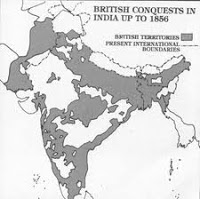The 1857 revolt is considered as the first serious attempt by Indians to end the British rule in India.It started as a movement in the upper Gangetic plain and central India, but continued long 90 years till India got her freedom. The Indian historian, Vir Savarkar was the first one to mention the revolt of 1857 as the first war of Indian Independence. Lets discuss about the causes, nature and people who involved in this revolt,which is considered as the first freedom struggle movement of India.
Places in focus
The revolt of 1857 began as a mutiny of sepoys of the East India Company's army on 10 May 1857, in the town of Meerut, and soon erupted into other mutinies and civilian rebellions largely in the upper Gangetic plain and central India, with the major hostilities confined to present-day Uttar Pradesh, Bihar, northern Madhya Pradesh, and the Delhi region.Other regions of Company-controlled India—Bengal province, the Bombay Presidency, and the Madras Presidency—remained largely calm. In Punjab, the Sikh princes backed the Company by providing both soldiers and support. The large princely states, Hyderabad, Mysore, Travancore, and Kashmir, as well as the smaller ones of Rajputana did not join the rebellion.
Causes of Revolt of 1857
The Indian Rebellion of 1857 did not occur as a result of one specific event;it was an accumulation of several political, economic, military and social causes, over time, resulting in its eventual outbreak.
Political causes
Doctrine of Lapse : The Doctrine of Lapse was part of the British policy of expansionism.If a feudal ruler did not leave a male heir through natural process, i.e. his own child, not an adopted one, the land became the property of the British East India Company. In eight years, Lord Dalhousie, the then Governor-General of India, annexed many kingdoms including Jhansi, Awadh or Oudh, Satara, Nagpur and Sambalpur.Feudal landholders, and royal armies found themselves unemployed and humiliated. Even the jewels of the royal family of Nagpur were publicly auctioned in Calcutta, a move that was seen as a sign of abject disrespect by the remnants of the Indian aristocracy.
Social Causes
Social reforms by British : The social reforms done by British were perceived as part of their westernisation process in India.The outlawing of Sati (self-immolation by widows) and child marriage, establishment of educational institutions etc which to some appeared to be a precursor to an imposition of Christianity, has also been put forward as a reason for the revolt.
Imposition of Christianity : Many East India Company officers took it upon themselves to try to convert their Sepoys event though East India Company strongly discouraged it.The Mughal Emperor Bahadur Shah Zafar told to Sepoys "We have joined hands to protect our religion and our faith."Zafar issued a proclamation stating that this was a religious war being prosecuted on behalf of 'the faith', and that all Muslim and Hindu residents of the imperial city, or of the countryside were encouraged to stay true to their faith and creeds.
Economic Causes
By 1848, the East India Company's financial difficulties had reached a point where expanding revenue required expanding British territories in South Asia massively. They introduced Doctrine of Lapse and as a result by 1857, the last vestiges of independent Indian states had disappeared and the Company exported untold quantities of gold, jewels, silver, silk, cotton, and a host of other precious materials back to England every year.This untold wealth of India is considered as the force behind public and private infrastructure expansion in Britain and Industrial Revolution. In certain areas farmers were forced to switch from subsistence farming to commercial crops such as indigo, jute, coffee and tea. This resulted in hardship to the farmers and increases in food prices. Local industry, specifically the famous weavers of Bengal and elsewhere, also suffered under British rule. Import tariffs were kept low, according to traditional British free-market sentiments, and thus the Indian market was flooded with cheap clothing from Britain. Master weavers had their fingers cut off to prevent them from weaving. Indigenous industry simply could not compete, and where once India had produced much of England's luxury cloth, the country was now reduced to growing cotton which was shipped to Britain to be manufactured into clothing, which was subsequently shipped back to India to be purchased by Indians. Also the Indians felt that the British were levying very heavy taxation on the locals. This included an increase in the taxation on land. This seems to have been the most important reason, keeping in view the speed at which the conflagration spread to the villages where farmers rushed to get back their unfairly grabbed title deeds.
Military Causes
Sympathetic rulers, such as Lord William Bentick were replaced by arrogant aristocrats such as Lord Dalhousie who despised the troops. The rebellion literally started over a gun. Sepoys throughout India were issued with a new rifle, the Pattern 1853 Enfield. It was believed that the cartridges that were issued with this rifle were greased with pork fat which was regarded as unclean by Muslims, or beef fat, regarded as sacred to Hindus. The sepoys believed that the government was deliberately trying to dishonour their cultural and religious identity.






0 comments: